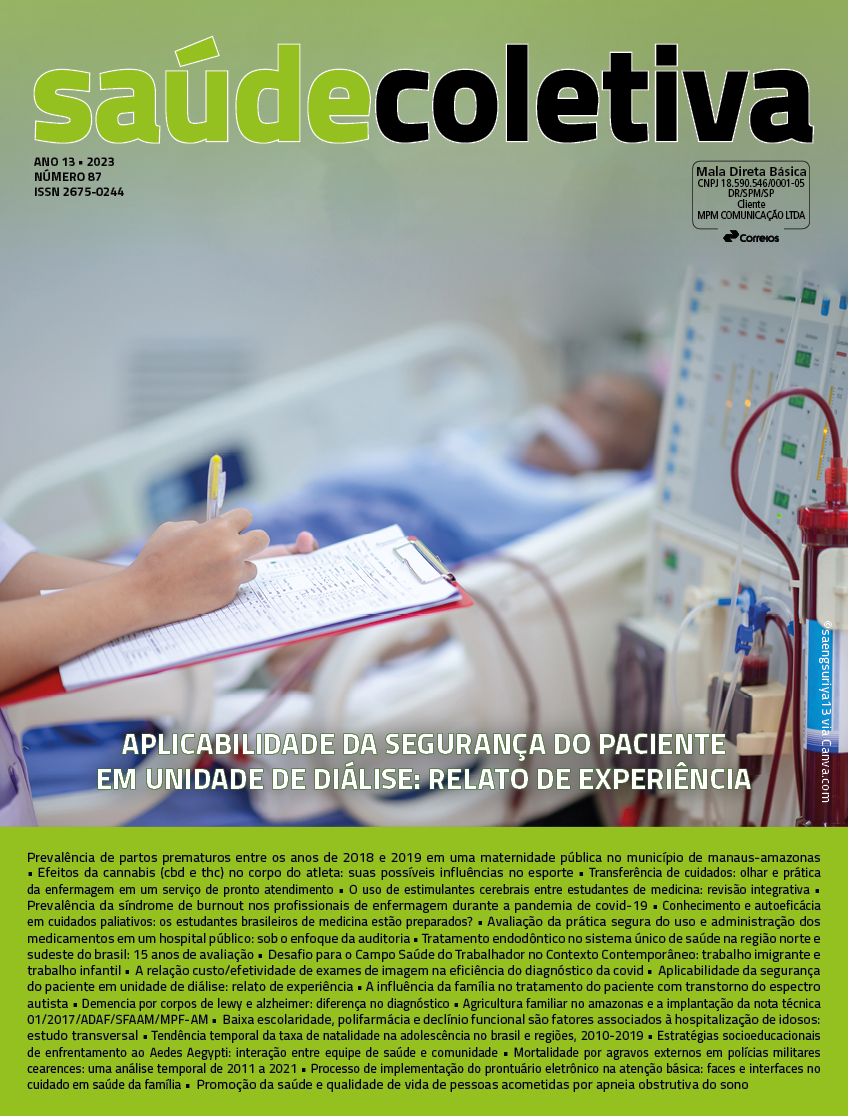Promoção da saúde e qualidade de vida de pessoas acometidas por apneia obstrutiva do sono
DOI:
https://doi.org/10.36489/saudecoletiva.2023v13i87p13095-13110Palavras-chave:
Apneia Obstrutiva do Sono, Doenças Otorrinolaringológicas, Promoção da Saúde, Qualidade de VidaResumo
Objetivo: Evidenciar em publicações científicas quanto estratégias de promoção da saúde como possibilidade de qualidade de vida de pessoas acometidas por Apneia Obstrutiva do Sono. Método: Revisão Integrativa de Literatura, realizada nas bases de dados Medical Literature Analysis and Retrieval System Online, Scientific Electronic Library Online, com leitura e análise crítica dos estudos de uma série temporal dos anos de 2010 a 2020. Resultados: Foram selecionados 23 artigos, sendo categorizados de acordo com três campos de atuação da Promoção da Saúde, segundo a Carta de Ottawa: Reforço a ação comunitária; Desenvolvimento de habilidades pessoais; e Reorientação dos serviços de saúde. Identificou-se nos estudos que as estratégias de ações de promoção da saúde incluíram aplicação de protocolos, formulários e questionários de avaliação aos pacientes, treinamento de atividade física, educação em saúde e emprego de tecnologias da comunicação e informação. Conclusão: As evidências revelaram de ações de promoção da saúde com grandes potenciais e possibilidades de capacitação das pessoas acometidas por Apneia Obstrutiva do Sono, e consequentemente motivação e preparo para atuação em prol da saúde e qualidade de vida.
Referências
World Health Organization. Ottawa charter for health promotion. Ottawa: World Health Organization/Health and Welfare Canada/Canada Public Health Association; 1986.
Heidemann ITSB, Cypriano CC, Gastaldo D, Jackson S, Rocha CG, Fagundes E. Estudo comparativo de práticas de promoção da saúde na atenção primária em Florianópolis, Santa Catarina, Brasil e Toronto, Ontário, Canadá Cad. Saúde Pública. 2018;34(4) :e00214516. Disponível em: https://doi.org/10.1590/0102-311X00214516 DOI: https://doi.org/10.1590/0102-311x00214516
Buss PM, Hartz ZMA, Pinto LF, Rocha CMF. Health promotion and quality of life: A historical perspective of the lasttwo 40 years (1980-2020). Ciência & Saúde Coletiva. 2020; 25(12):4723-35, 2020.Available from: https://doi.org/10.1590/1413-812320202512.15902020
Gouveia MC et al. Tratado de Otorrinolaringologia e Cirurgia Cervicofacial da Aborl-Ccf. 3o ed. GEN: Guanabara Koogan, 2017. ISBN: 9788535289039
Lins-Filho OL, Pedrosa RP, Gomes JML, Dantas Moraes SL, Vasconcelos BCE, Lemos CAA, et al. Effectof exercise training on subjective parameters in patients with obstructive sleep apnea: a systematic review and meta-analysis. Sleep Medicine, vol. 69: Elsevier B.V. 2020. 1-7p. DOI: https://doi.org/10.1016/j.sleep.2019.12.022
Carneiro-Barrera A, Amaro-Gahete FJ, Díaz-Román A, Guillén-Riquelme A, Jurado-Fasoli L, Sáez-Roca G, et al. Interdisciplinary weightlossand lifestyle intervention for obstructive sleep apnoea in adults: Rationale, design and methodology of the interapnea study. Nutrients. 2019;11(9): 2227. Available from: https://doi.org/10.3390/nu11092227. DOI: https://doi.org/10.3390/nu11092227
Mehrtash M, Bakker JP, Ayas N. Predictorsof Continuous Positive Airway Pressure Adherence in Patients with Obstructive Sleep Apnea. Lung. 2019;197(2):115-21.Availablefrom:https://doi.org/10.1007/s00408-018-00193-1. DOI: https://doi.org/10.1007/s00408-018-00193-1
Chang HP, Chen YF, Du JK. Obstructive sleep apnea treatment in adults. Kaohsiung Journal of Medical Sciences. 2020;36(1):7-12. Available from: https://doi.org/10.1002/kjm2.12130. DOI: https://doi.org/10.1002/kjm2.12130
Silva RP, Martinez D, Lopez P, Cadore EL. Effectofstrength training on sleep apnea severity in theelderly: Studyprotocol for a randomized controle dtrial. Trials. 2017;18(1).Available from: https://doi.org/10.1186/s13063-017-2238-3. DOI: https://doi.org/10.1186/s13063-017-2238-3
Whittemore R, Knafl K. The integrative review: updated methodology. Journal of Advanced Nursing. 2005;52(5):546–53. Available from: https://doi.org/ 10.1111/j.1365-2648.2005.03621.x. DOI: https://doi.org/10.1111/j.1365-2648.2005.03621.x
Lockwood C, Porrit K, Munn Z, Rittenmeyer L, Salmond S, Bjerrum M, Loveday H, Carrier J, Stannard D. Chapter 2: Systematic reviews ofqualitativeevidence. In: Aromataris E, Munn Z (Editors). JBI Manual for Evidence Synthesis. JBI, 2020. Available from: https://synthesismanual.jbi.global. https://doi.org/10.46658/JBIMES-20-03 DOI: https://doi.org/10.46658/JBIRM-17-02
Page MJ, McKenzie JE, Bossuyt PM, Boutron I, Hoffmann TC, Mulrow CD, et al. The PRISMA 2020 statement: na up dated guideline for reporting systematic reviews. BMJ. 2021;372:n71.Available from: https://doi.org/10.1136/bmj.n71 DOI: https://doi.org/10.1136/bmj.n71
Moss J, Tew GA, Copeland RJ, Stout M, Billings CG, Saxton JM, et al. Effectsof a pragmatic lifestyle intervention for reducing body mass in obese adults with obstructive sleep apnoea: A randomised controlled trial. BioMed Res Int. 2014; 2014: 102164.Available from: https://doi.org/10.1155/2014/102164 DOI: https://doi.org/10.1155/2014/102164
Cukor D, Pencille M, ver Halen N, Primus N, Gordon-Peters V, Fraser M, et al. An RCT comparing remotely deliveredad herence promotion for sleep apnea assessment againstan information control in a black community sample. Sleep Health. 2018;4(4):369–76.Availablefrom: https://doi.org/10.1016/j.sleh.2018.05.001 DOI: https://doi.org/10.1016/j.sleh.2018.05.001
Abma IL, Rovers MM, Ijff M, Hol B, Nägele M, Westert GP, et al. Does the Patient-Reported Apnea Questionnaire (PRAQ) increase patient-centredness in the daily practice of sleep centres? a mixed-methodsstudy. BMJ Open. 2019;9:e025963.Available from:https://doi.org/10.1136 / bmjopen-2018-025963 DOI: https://doi.org/10.1136/bmjopen-2018-025963
Hu ST, Yu CC, Liu CY, Tsao LI. The effects of integrated nursing educationon quality of life and health-related outcomes amongo bstructive sleep apnea patients receiving continuous positive airway pressure the rapy. Sleep andBreathing. 2017;21(4):845–52.Available from: https://doi.org/10.1007 / s11325-017-1480-y DOI: https://doi.org/10.1007/s11325-017-1480-y
Kline CE, Ewing GB, Burch JB, Blair SN, Durstine JL, Davis JM, et al. Exercise training improves selected aspects of day time functioning in adults with obstructive sleep apnea. Journal of Clinical Sleep Medicine. 2012;8(4):357–65.Availablefrom:http://dx.doi.org/10.5664/jcsm.2022 DOI: https://doi.org/10.5664/jcsm.2022
Silva MVFP, Lustosa TC, Arai VJ, Couto Patriota TLG, Lira MPF, Lins-Filho OL, et al. Effects of acupuncture on obstructive sleep apnea severity, blood pressure controland quality of life in patients with hypertension: A randomized controlled trial. J Sleep Res. 2020;29: e12954.Available from:http://dx.doi.org/10.1111 / jsr.12954 DOI: https://doi.org/10.1111/jsr.12954
Olsen S, Smith SS, Oei TPS, Douglas J. Motivation alinterviewing (MINT) improves continuous positive airway pressure (CPAP) acceptance and adherence: A randomized controlled trial. Journal of Consulting and Clinical Psychology. 2012;80(1):151–63. Available from:http://dx.doi.org/10.1037 / a0026302 DOI: https://doi.org/10.1037/a0026302
Lugo VM, Garmendia O, Suarez-Girón M, Torres M, Vázquez-Polo FJ, Negr ́ı́n MA, et al. Gerenciamento abrangente da apneia obstrutiva do sono por telemedicina: melhoria clínica e custo-efetividade de uma unidade virtual de sono. Um ensaio clínico randomizado. PLoS ONE. 2019;14(10): e0224069. Disponível em:http://dx.doi.org/10.1371/journal.pone.0224069 DOI: https://doi.org/10.1371/journal.pone.0224069
Robbins R, Senathirajah Y, Williams NJ, Hutchinson C, Rapoport DM, Allegrante JP, et al. Developing a Tailored Website for Promoting Awareness about Obstructive Sleep Apnea (OSA) Among Blacks in Community-Based Settings. Health Communication. 2019;34(5):567–75. Availa ble from: http://dx.doi.org/10.1080 /10410236.2018.1423865 DOI: https://doi.org/10.1080/10410236.2018.1423865
Van Maanen JP, de Vries N. Long-termeffectiveness and compliance of position altherapy with the sleep position trainer in thetreatmentofpositionalobstructivesleepapneasyndrome. Sleep. 2014;37(7):1209-15. Available from:http://dx.doi.org/10.5665/sleep.3840. DOI: https://doi.org/10.5665/sleep.3840
Servantes DM, Javaheri S, Kravchychyn ACP, Storti LJ, Almeida DR, de Mello MT, et al. Effects of Exercise Training and CPAP in Patients With Heart Failure and OSA: A PreliminaryStudy. Chest. 2018 Oct 1;154(4):808–17. Available from: https://doi.org/10.1016/j.chest.2018.05.011 DOI: https://doi.org/10.1016/j.chest.2018.05.011
Isetta V, Negrín MA, Monasterio C, Masa JF, Feu N, Álvarez A, et al. A Bayesiancost-effectiveness analysis of a telemedicine-basedstrategy for the management of sleep apnoea: A multicentre randomisedcontrolled trial. Thorax. 2015;70(11):1054–61. Available from: https://doi.org/10.1136/thoraxjnl-2015-207032 DOI: https://doi.org/10.1136/thoraxjnl-2015-207032
Sparrow D, Aloia M, DeMollesDA, Gottlieb DJ. A telemedicine interventionto improve adherenceto continuous positive airway pressure: A randomised controlled trial. Thorax. 2010;65(12):1061-6. Disponível em:https://doi.org/10.1136 / thx.2009.133215 DOI: https://doi.org/10.1136/thx.2009.133215
Bouloukaki I, Giannadaki K, Mermigkis C, Tzanakis N, Mauroudi E, Moniaki V, et al. Intensive versus standard follow-up to improve continuous positive airway pressure compliance. Eur Respir J. 2014;44(5):1262–74. Available from: https://doi.org/10.1183 / 09031936.00021314 DOI: https://doi.org/10.1183/09031936.00021314
Garbarino S, Magnavita N. Obstructive Sleep Apnea Syndrome (OSAS), metabolic syndrome and mental health in smal lenterprise workers. Feasibility of anaction for health. PLoS ONE. 2014;9(5) e97188. Available from: https://doi.org/ 10.1371/journal.pone.0097188 DOI: https://doi.org/10.1371/journal.pone.0097188
Tuomilehto H, Seppä J, Uusitupa M, Peltonen M, Martikainen T, Sahlman J, et al. The impacto fweightreduction in theprevention of the progression of obstructive sleep apnea: An explanatory analysis of a 5-year observational follow-up trial. Sleep Medicine. 2014;15(3):329-35. Available from: http://dx.doi.org/10.1016/j.sleep.2013.11.786. DOI: https://doi.org/10.1016/j.sleep.2013.11.786
Ackel-D’Elia C, Silva AC da, Silva RS, Truksinas E, Sousa BS, Tufik S, et al. Effects ofexercise training associated with continuous positive airway pressure treatment in patients with obstructive sleep apnea syndrome. Sleep and Breathing. 2012;16(3):723–35. Available from:10.1007 / s11325-011-0567-0 DOI: https://doi.org/10.1007/s11325-011-0567-0
Pépin JL, Jullian-Desayes I, Sapène M, Treptow E, Joyeux-Faure M, Benmerad M, et al. Multimodal Remote Monitoringof High Cardiovascular Risk Patients with OSA Initiating CPAP: A Randomized Trial. Chest. 2019;155(4):730–9. Available from: https://doi.org/10.1016/j.chest.2018.11.007 DOI: https://doi.org/10.1016/j.chest.2018.11.007
Schütz TC, Cunha TC, Moura-Guimarães T, Luz GP, Ackel-D'Elia C, Alves ES, et al. Comparação dos efeitos da pressão positiva contínua nas vias aéreas, aparelho oral e treinamento físico na síndrome da apnéia obstrutiva do sono. Clinics. 2013; 68 (8): 1168-1174.Available from: https://doi.org/10.6061/clínicas/2013(08)17
Herkenrath SD, Treml M, Priegnitz C, Galetke W, Randerath WJ. Effects of respiratory muscle training (RMT) in patients with mildto moderate obstructive sleep apnea (OSA). Sleepand Breathing. 2018;22(2):323-8. Availablefrom:https://doi.org/10.1007/s11325-017-1582-6 DOI: https://doi.org/10.1007/s11325-017-1582-6
Lai A, Fong D, Lam J, Mensagem I. Eficácia a longo prazo de um programa de educação para melhorar a adesão com resultados positivos contínuos tratamento de pressão das vias aéreas para obstrução apneia do sono [Internet]. Hong Kong Med J. 2017; 23 (Suppl 2): S24-7. PMID: 29938667. Available from: https://pubmed.ncbi.nlm.nih.gov/29938667/.
Jackson M, Collins A, Berlowitz D, Howard M, O’Donoghue F, Barnes M. Efficacyof sleep position modification totreatposition alobstructive sleep apnea. Sleep Medicine. 2015;16(4):545-52. Availablefrom:https://doi.org/10.1016/j.sleep.2015.01.008 DOI: https://doi.org/10.1016/j.sleep.2015.01.008
Gokmen GY, Akkoyunlu ME, Kilic L, Algun C. The Effectof T’ai Chi and Qigong Training on Patientswith Obstructive Sleep Apnea: A Randomized Controlled Study. Journal of Alternativeand Complementary Medicine. 2019;25(3):317-25. Available from:https://doi.org/10.1089 / acm.2018.0197 DOI: https://doi.org/10.1089/acm.2018.0197
Czeresnia, D; Freitas, C. Promoção da Saúde: conceitos, reflexões, tendências. Rio de Janeiro: Editora Fiocruz. 2009. DOI: https://doi.org/10.7476/9788575413531
Roso A, Romanini M. Empoderamento individual, empoderamento comunitário e conscientização: um ensaio teórico. Psicologia e Saber Social. 2014; 3(1):83-95. Available from: https://www.e-publicacoes.uerj.br/index.php/psi-sabersocial/article/view/12203. DOI: https://doi.org/10.12957/psi.saber.soc.2014.12203
Kleba, ME; Wendausen A. Empoderamento: processo de fortalecimento dos sujeitos nos espaços de participação social e democratização política. Saúde Soc. São Paulo. 2009;18(4):733-743. Disponível em:https://doi.org/10.1590/S0104-12902009000400016 DOI: https://doi.org/10.1590/S0104-12902009000400016
Gamboa, LVC. Práticas de promoção da saúde no contexto da atenção primária no Brasil e no mundo: o descompasso teoria e prática. APS em revista. 2019;1(1):50-61. Disponível em:https://doi.org/10.14295/aps.v1i1.3 DOI: https://doi.org/10.14295/aps.v1i1.3
Queiroz DLC, Yui MS, Braga AA, Coelho ML, Küpper DS, Sander HH, et al. Adherenceofobstructivesleepapneasyndromepatientstocontinuous positive airwaypressure in a publicservice. Braz J Otorhinolaryngol. 2014;80(2):126-30. Availablefrom:https://doi.org/10.5935/1808-8694.20140027. DOI: https://doi.org/10.5935/1808-8694.20140027
Silva TC, Carvalho AG, Tholl AD, Borrego MAR, Soto PJL, Viegas SMF. SAÚDE DEBATE. A tecnossocialidade no cotidiano de profissionais da atenção primária e promoção da saúde: scoping review. Saúde Debate. 2021;45(131): 1183-1198. Available from: https://doi.org/10.1590/0103-1104202113117 DOI: https://doi.org/10.1590/0103-1104202113117i
Maeyama MA, Jasper CH, Nilson LG, Dolny LL, Cutolo LRA. Promoção da saúde como tecnologia para transformação social. Revista Brasileira de Tecnologias Sociais. 2015;2(2):129-143. Disponível em: https://doi.org/10.14210/rbts.v2n2.p129-143 DOI: https://doi.org/10.14210/rbts.v2n2.p129-143







